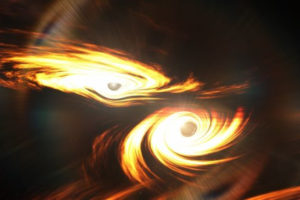Scientists confirm the first detection, using gravitational-wave astronomy, of a black hole in the upper mass gap
Scientists confirm the first detection, using gravitational-wave astronomy, of a black hole in the upper mass gap.
LIGO and Virgo have detected the heftiest black hole merger to date, giving birth to a new black hole that weighs in at some 142 solar masses. This cosmic middleweight is the first direct observation of the birth of an elusive intermediate-mass black hole. (Credit: Mark Myers, ARC Centre of Excellence for Gravitational Wave Discovery (OzGrav))
Within five years of detecting the first gravitational waves, LIGO and Virgo scientists have yet again helped advance our understanding of the cosmos.
On May 21, 2019, researchers identified a unique set of gravitational waves, or ripples in the fabric of space-time, that they haven’t seen before. For one, the waves came from halfway across the universe, or about 7 billion light-years away, making it the most distant gravitational-wave signal ever detected.
But more importantly, the researchers think these gravitational waves point to the merger of two already bizarre black holes that formed a never-before-confirmed mid-sized black hole. In other words, the researchers think they’ve found the first direct evidence for a special breed of black hole called an intermediate-mass black hole (IMBH).
Astronomers think IMBHs fill a gap between stellar-mass black holes (which are a few to 100 solar masses and are created when huge stars collapse), and supermassive black holes (which are millions to billions of solar masses and lurk in the centers of most galaxies). And although the exact mass range of each class of black hole depends on who you ask, most astronomers agree that, at 142 solar masses, this newly formed object fits the bill for an IMBH.





